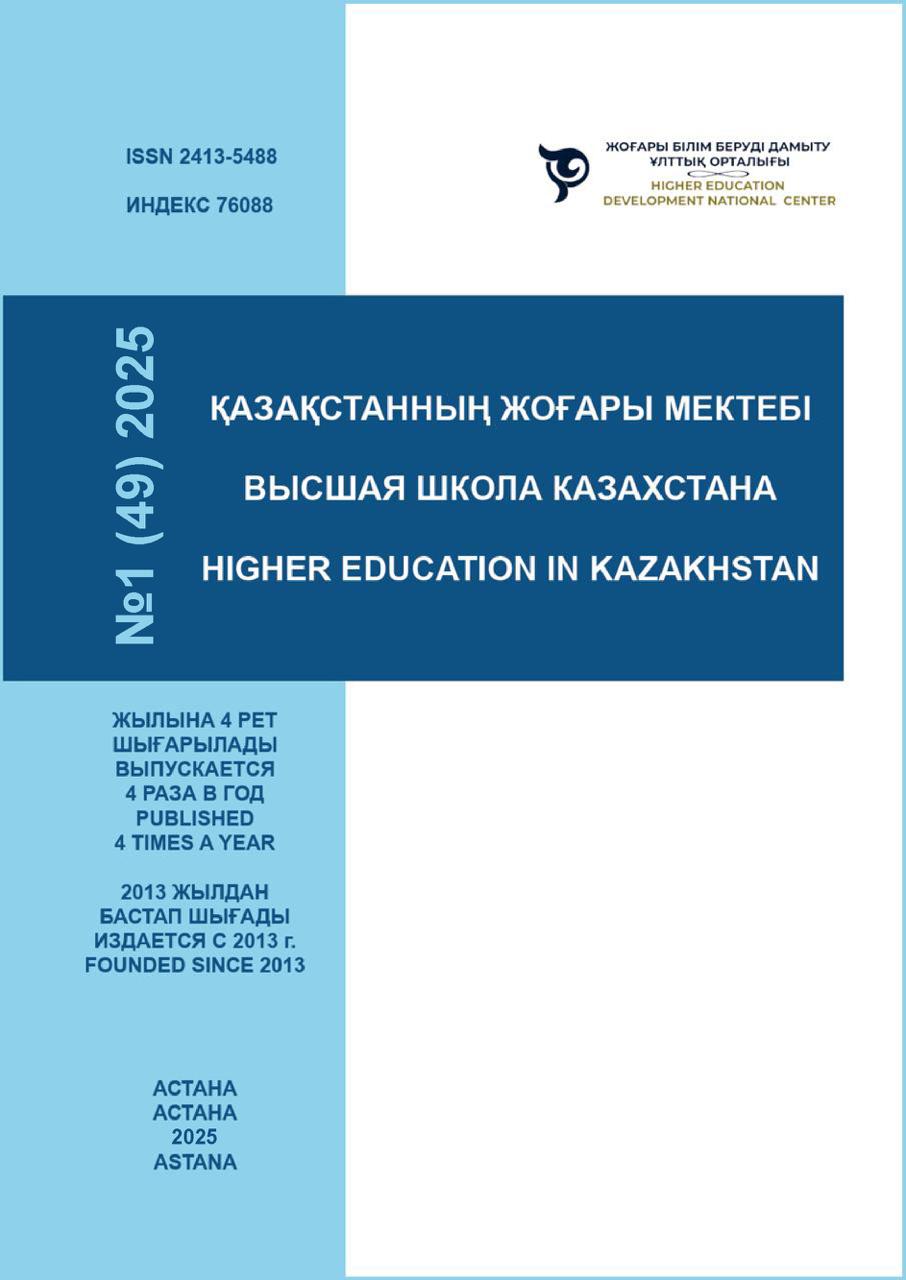ENHANCING COMPETENCIES AND MOTIVATION: THE IMPACT OF 360-DEGREE VIDEO TECHNOLOGY ON FUTURE FOREIGN LANGUAGE TEACHERS
DOI:
https://doi.org/10.59787/2413-5488-2025-49-1-67-82Кілт сөздер:
360-degree video, intercultural competence, authentic educational situations, technological competence, creativity thinking, differentiated approach, methodological competenceАңдатпа
This study examines an innovative approach to the training of foreign language teachers using 360-degree video technology. The current method is a unique combination of existing techniques, combining immersive learning and the development of professional competencies. The investigation highlights the novelty of the problem, which lies in the lack of development of approaches that integrate immersive technologies into the professional education of teachers. The research conducted among students of the Eurasian National University who completed a course on integrating 360-degree video into the educational process. The focus is on analyzing the impact of 360-degree video technology on the development of key professional competencies: pedagogical adaptability, cultural awareness, classroom management skills, reflective practices, technology proficiency, and student engagement strategies. The model presented in the study demonstrates the interrelationship of these competencies, suggesting a new research paradigm for teacher education. The results showed a significant improvement in all competencies after using technology, especially in the areas of creative thinking (+7 points) and technological competence (+7 points). There was also an increase in student motivation due to the use of new teaching methods.
Әдебиеттер тізімі
Bennett, M. J. (1998). Intercultural communication: A current perspective. In M. J. Bennett (Ed.), Basic concepts of intercultural communication: Selected readings. Intercultural Press.
Chen, C. H., Hung, H. T., & Yeh, H. C. (2021). Virtual reality in problem-based learning contexts: Effects on the problem-solving performance, vocabulary acquisition, and motivation of English language learners. Journal of Computer Assisted Learning, 37(3), 851–860. https://doi.org/10.1111/jcal.12528
Concannon, B. J., Esmail, S., & Roberts, M. R. (2019). Head-mounted display virtual reality in post-secondary education and skill training. Frontiers in Education, 4(80), 1–23. https://doi.org/10.3389/feduc.2019.00080
Common European Framework of Reference for languages: learning, teaching, assessment language policy unit, Strasbourg www.coe.int/lang-cefr
Fukuta, J., Gill, N., Rooney, R., Coombs, A., & Murphy, D. (2021). Use of 360 video for a virtual operating theatre orientation for medical students. Journal of Surgical Education, 78(2), 391–393. https://doi.org/10.1016/j.jsurg.2020.08.014
Guilford, J. P. (1986). Creative talents: Their nature, uses, and development. Bearly Limited.
Han, J., & Yin, H. (2016). Teacher motivation: Definition, research development and implications for teachers. Cogent Education, 3(1). https://doi.org/10.1080/2331186X.2016.1217819
Harrington, C. M., Kavanagh, D. O., Wright Ballester, G., Wright Ballester, A., Dicker, P., Traynor, O., Hill, A., & Tierney, S. (2018). 360 operative videos: A randomised cross-over study evaluating attentiveness and information retention. Journal of Surgical Education, 75, 993– 1000. https://doi.org/10.1016/j.jsurg.2017.10.010
Heylighen, F. (2000). Referencing pages in Principia Cybernetica Web. In F. Heylighen, C. Joslyn, & V. Turchin (Eds.), Principia Cybernetica Web. http://cleamc11.vub.ac.be/REFERPCP.html
Huber, T., Paschold, M., Hansen, C., Wunderling, T., Lang, H., & Kneist, W. (2017). New dimensions in surgical training: Immersive virtual reality laparoscopic simulation exhilarates surgical staff. Surgical Endoscopy, 31, 4472–4477. https://doi.org/10.1007/s00464-017-5500-6
Johnson, C. D. L. (2018). Using virtual reality and 360-degree video in the religious studies classroom: An experiment. Teaching Theology and Religion, 21, 228–241. https://doi.org/10.1111/teth.12446
Lave, J., & Wenger, E. (1991). Situated learning: Legitimate peripheral participation. Cambridge University Press.
Mishra, P., & Koehler, M. J. (2006). Technological Pedagogical Content Knowledge: A framework for teacher knowledge. Teachers College Record, 108(6), 1017–1054. https://doi.org/10.1111/j.1467-9620.2006.00684.x
Mouatt, B., Smith, A. E., Mellow, M. L., Parfitt, G., Smith, R. T., & Stanton, T. R. (2020). The use of virtual reality to influence motivation, affect, enjoyment, and engagement during exercise: A scoping review. Frontiers in Virtual Reality, 1. https://doi.org/10.3389/frvir.2020.564664
Plucker, J. A. (Ed.). (2022). Creativity and innovation: Theory, research, and practice (2nd ed.). Routledge. https://doi.org/10.4324/9781003233923
Repetto, C., Di Natale, A. F., Villani, D., Triberti, S., Germagnoli, S., & Riva, G. (2021). The use of immersive 360 videos for foreign language learning: A study on usage and efficacy among high-school students. Interactive Learning Environments, 1–16. https://doi.org/10.1080/10494820.2020.1863234
Rupp, M. A., Odette, K. L., Kozachuk, J., Michaelis, J. R., Smither, J. A., & McConnell, D. S. (2019). Investigating learning outcomes and subjective experiences in 360-degree videos. Computers & Education, 128, 256–268. https://doi.org/10.1016/j.compedu.2018.09.015
Ryan, R. M., & Deci, E. L. (2000). Intrinsic and extrinsic motivations: Classic definitions and new directions. Contemporary Educational Psychology, 25(1), 54–67. https://doi.org/10.1006/ceps.1999.1020
Ryan, R. M., & Deci, E. L. (2000). Self-determination theory and the facilitation of intrinsic motivation, social development, and well-being. American Psychologist, 55(1), 68–78. https://doi.org/10.1037/0003-066X.55.1.68
Snelson, C., & Hsu, Y. C. (2020). Educational 360-degree videos in virtual reality: A scoping review of the emerging research. TechTrends, 64(3), 404–412. https://doi.org/10.1007/s11528-019-00474-3
Shadiev R, Yu J and Sintawati W (2021) Exploring the Impact of Learning Activities Supported by 360-Degree Video Technology on Language Learning, Intercultural Communicative Competence Development, and Knowledge Sharing. Front. Psychol. 12:766924. https://doi.org/10.3389/fpsyg.2021.766924
Shadiev R., Yingying Feng, Roza Zhussupova, Yueh-Min Huang. (2024). Intercultural competence development through a tele-collaborative project supported by speech-enabled corrective feedback technology. Journal of Computer Assisted Learning. Volume 40, Issue 2, p. 697-714. https://doi.org/10.1111/jcal.12906
Taylor, N., & Layland, A. (2019). Comparison study of the use of 360-degree video and non-360-degree video simulation and cybersickness symptoms in undergraduate healthcare curricula. BMJ Simulation and Technology Enhanced Learning, 5, 170–173. https://doi.org/10.1136/bmjstel-2018-000356
Tomlinson, C. A. (2000). Differentiation of instruction in the elementary grades.
Wu, J., Guo, R., Wang, Z., & Zeng, R. (2021). Integrating spherical video-based virtual reality into elementary school students’ scientific inquiry instruction: Effects on their problem-solving performance. Interactive Learning Environments, 29(3), 496–509. https://doi.org/10.1080/10494820.2019.1587469
Ye, X., Liu, P. F., Lee, X. Z., Zhang, Y. Q., & Chiu, C. K. (2021). Classroom misbehaviour management: An SVVR-based training system for preservice teachers. Interactive Learning Environments, 29(1), 112–129. https://doi.org/10.1080/10494820.2019.1579235
Zulkiewicz, B. A., Boudewyns, V., Gupta, C., Kirschenbaum, A., & Lewis, M. A. (2020). Using 360-degree video as a research stimulus in digital health studies: Lessons learned. JMIR Serious Games, 8(1), e15422. https://doi.org/10.2196/15422

Жүктеулер
Жарияланды
Журналдың саны
Бөлім
Лицензия
Авторлық құқық (c) 2025 "Қазақстанның жоғары мектебі" ғылыми-сараптамалық журналы

Бұл жұмыс Creative Commons Attribution-Коммерциялық емес 4.0 халықаралық лицензиясы.













